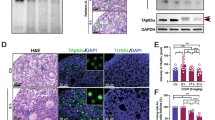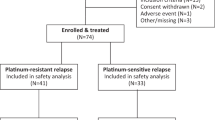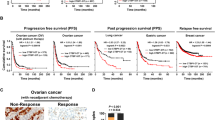Abstract
Non-proliferating oocytes within avascular regions of the ovary are exquisitely susceptible to chemotherapy. Early menopause and sterility are unintended consequences of chemotherapy, and efforts to understand the oocyte apoptotic pathway may provide new targets for mitigating this outcome. Recently, the c-Abl kinase inhibitor imatinib mesylate (imatinib) has become the focus of research as a fertoprotective drug against cisplatin. However, the mechanism by which imatinib protects oocytes is not fully understood, and reports of the drug’s efficacy have been contradictory. Using in vitro culture and subrenal grafting of mouse ovaries, we demonstrated that imatinib inhibits the cisplatin-induced apoptosis of oocytes within primordial follicles. We found that, before apoptosis, cisplatin induces c-Abl and TAp73 expression in the oocyte. Oocytes undergoing apoptosis showed downregulation of TAp63 and upregulation of Bax. While imatinib was unable to block cisplatin-induced DNA damage and damage response, such as the upregulation of p53, imatinib inhibited the cisplatin-induced nuclear accumulation of c-Abl/TAp73 and the subsequent downregulation of TAp63 and upregulation of Bax, thereby abrogating oocyte cell death. Surprisingly, the conditional deletion of Trp63, but not ΔNp63, in oocytes inhibited apoptosis, as well as the accumulation of c-Abl and TAp73 caused by cisplatin. These data suggest that TAp63 is the master regulator of cisplatin-induced oocyte death. The expression kinetics of TAp63, c-Abl and TAp73 suggest that cisplatin activates TAp63-dependent expression of c-Abl and TAp73 and, in turn, the activation of TAp73 by c-Abl-induced BAX expression. Our findings indicate that imatinib protects oocytes from cisplatin-induced cell death by inhibiting c-Abl kinase, which would otherwise activate TAp73-BAX-mediated apoptosis. Thus, imatinib and other c-Abl kinase inhibitors provide an intriguing new way to halt cisplatin-induced oocyte death in early follicles and perhaps conserve the endocrine function of the ovary against chemotherapy.
Similar content being viewed by others
Log in or create a free account to read this content
Gain free access to this article, as well as selected content from this journal and more on nature.com
or
Abbreviations
- BAX:
-
Bcl-2-associated X protein
- ATM:
-
Ataxia telangiectasia mutated
- ATR:
-
Atm and Rad3-related
- GDF9:
-
Growth differentiation factor 9
- EGFP:
-
Enhanced green fluorescent protein
- PUMA:
-
p53 upregulated modulator of apoptosis
- BAK:
-
Bcl-2 homologous antagonist killer
- NSG:
-
NOD-scid gamma
- FSH:
-
Follicle-stimulating hormone
- PARP:
-
Poly-ADP ribose polymerase
- TSA:
-
Tyramide Signaling Amplification
- DAB:
-
3,3-diaminobenzidine
References
Minton SE, Munster PN . Chemotherapy-induced amenorrhea and fertility in women undergoing adjuvant treatment for breast cancer. Cancer Control 2002; 9: 466–472.
Jeruss JS, Woodruff TK . Preservation of fertility in patients with cancer. N Engl J Med 2009; 360: 902–911.
Meirow D . Ovarian injury and modern options to preserve fertility in female cancer patients treated with high dose radio-chemotherapy for hemato-oncological neoplasias and other cancers. Leuk Lymphoma 1999; 33: 65–76.
Kerr JB, Brogan L, Myers M, Hutt KJ, Mladenovska T, Ricardo S et al. The primordial follicle reserve is not renewed after chemical or gamma-irradiation mediated depletion. Reproduction 2012; 143: 469–476.
Muscari Lin E, Aikin JL, Good BC . Premature menopause after cancer treatment. Cancer Pract 1999; 7: 114–121.
Woodruff TK . The Oncofertility Consortium—addressing fertility in young people with cancer. Nature reviews. Clin Oncol 2010; 7: 466–475.
Zelinski MB, Murphy MK, Lawson MS, Jurisicova A, Pau KY, Toscano NP et al. In vivo delivery of FTY720 prevents radiation-induced ovarian failure and infertility in adult female nonhuman primates. Fertil Steril 2011; 95: 1440–1445 e1-7.
Gonfloni S, Di Tella L, Caldarola S, Cannata SM, Klinger FG, Di Bartolomeo C et al. Inhibition of the c-Abl-TAp63 pathway protects mouse oocytes from chemotherapy-induced death. Nat Med 2009; 15: 1179–1185.
Kerr JB, Hutt KJ, Cook M, Speed TP, Strasser A, Findlay JK et al. Cisplatin-induced primordial follicle oocyte killing and loss of fertility are not prevented by imatinib. Nat Med 2012; 18: 1170–1172.
Maiani E, Di Bartolomeo C, Klinger FG, Cannata SM, Bernardini S, Chateauvieux S et al. Reply to: cisplatin-induced primordial follicle oocyte killing and loss of fertility are not prevented by imatinib. Nat Med 2012; 18: 1172–1174.
Woodruff TK . Preserving fertility during cancer treatment. Nat Med 2009; 15: 1124–1125.
Levine AJ, Tomasini R, McKeon FD, Mak TW, Melino G . The p53 family: guardians of maternal reproduction. Nat Rev Mol Cell Biol 2011; 12: 259–265.
Coutandin D, Ou HD, Lohr F, Dotsch V . Tracing the protectors path from the germ line to the genome. Proc Natl Acad Sci USA 2010; 107: 15318–15325.
Pankow S, Bamberger C . The p53 tumor suppressor-like protein nvp63 mediates selective germ cell death in the sea anemone Nematostella vectensis. PLoS One 2007; 2: e782.
Schumacher B, Hofmann K, Boulton S, Gartner A . The C. elegans homolog of the p53 tumor suppressor is required for DNA damage-induced apoptosis. Curr Biol 2001; 11: 1722–1727.
Derry WB, Putzke AP, Rothman JH . Caenorhabditis elegans p53: role in apoptosis, meiosis, and stress resistance. Science 2001; 294: 591–595.
Yamada Y, Davis KD, Coffman CR . Programmed cell death of primordial germ cells in Drosophila is regulated by p53 and the Outsiders monocarboxylate transporter. Development 2008; 135: 207–216.
Lane DP, Madhumalar A, Lee AP, Tay BH, Verma C, Brenner S et al. Conservation of all three p53 family members and Mdm2 and Mdm4 in the cartilaginous fish. Cell Cycle 2011; 10: 4272–4279.
Yin Y, Stahl BC, DeWolf WC, Morgentaler A . p53-mediated germ cell quality control in spermatogenesis. Dev Biol 1998; 204: 165–171.
Chandrasekaran Y, Richburg JH . The p53 protein influences the sensitivity of testicular germ cells to mono-(2-ethylhexyl) phthalate-induced apoptosis by increasing the membrane levels of Fas and DR5 and decreasing the intracellular amount of c-FLIP. Biol Reprod 2005; 72: 206–213.
Petre-Lazar B, Livera G, Moreno SG, Trautmann E, Duquenne C, Hanoux V et al. The role of p63 in germ cell apoptosis in the developing testis. J Cell Physiol 2007; 210: 87–98.
Codelia VA, Cisterna M, Alvarez AR, Moreno RD . p73 participates in male germ cells apoptosis induced by etoposide. Mol Hum Reprod 2010; 16: 734–742.
Kerr JB, Hutt KJ, Michalak EM, Cook M, Vandenberg CJ, Liew SH et al. DNA damage-induced primordial follicle oocyte apoptosis and loss of fertility require TAp63-mediated induction of Puma and Noxa. Mol Cell 2012; 48: 343–352.
Kurita T, Cunha GR, Robboy SJ, Mills AA, Medina RT . Differential expression of p63 isoforms in female reproductive organs. Mech Dev 2005; 122: 1043–1055.
Suh EK, Yang A, Kettenbach A, Bamberger C, Michaelis AH, Zhu Z et al. p63 protects the female germ line during meiotic arrest. Nature 2006; 444: 624–628.
Livera G, Petre-Lazar B, Guerquin MJ, Trautmann E, Coffigny H, Habert R . p63 null mutation protects mouse oocytes from radio-induced apoptosis. Reproduction 2008; 135: 3–12.
Deutsch GB, Zielonka EM, Coutandin D, Weber TA, Schafer B, Hannewald J et al. DNA damage in oocytes induces a switch of the quality control factor TAp63alpha from dimer to tetramer. Cell 2011; 144: 566–576.
Perez GI, Knudson CM, Leykin L, Korsmeyer SJ, Tilly JL . Apoptosis-associated signaling pathways are required for chemotherapy-mediated female germ cell destruction. Nat Med 1997; 3: 1228–1232.
Tomasini R, Tsuchihara K, Wilhelm M, Fujitani M, Rufini A, Cheung CC et al. TAp73 knockout shows genomic instability with infertility and tumor suppressor functions. Genes Dev 2008; 22: 2677–2691.
van Hennik MB, van der Vijgh WJ, Klein I, Elferink F, Vermorken JB, Winograd B et al. Comparative pharmacokinetics of cisplatin and three analogues in mice and humans. Cancer Res 1987; 47: 6297–6301.
Demetri GD, Wang Y, Wehrle E, Racine A, Nikolova Z, Blanke CD et al. Imatinib plasma levels are correlated with clinical benefit in patients with unresectable/metastatic gastrointestinal stromal tumors. J Clin Oncol 2009; 27: 3141–3147.
Takai Y, Canning J, Perez GI, Pru JK, Schlezinger JJ, Sherr DH et al. Bax, caspase-2, and caspase-3 are required for ovarian follicle loss caused by 4-vinylcyclohexene diepoxide exposure of female mice in vivo. Endocrinology 2003; 144: 69–74.
Ghafari F, Gutierrez CG, Hartshorne GM . Apoptosis in mouse fetal and neonatal oocytes during meiotic prophase one. BMC Dev Biol 2007; 7: 87.
Yang F, Baumann C, De La Fuente R . Persistence of histone H2AX phosphorylation after meiotic chromosome synapsis and abnormal centromere cohesion in poly (ADP-ribose) polymerase (Parp-1) null oocytes. Dev Biol 2009; 331: 326–338.
Liedert B, Pluim D, Schellens J, Thomale J . Adduct-specific monoclonal antibodies for the measurement of cisplatin-induced DNA lesions in individual cell nuclei. Nucleic Acids Res 2006; 34: e47.
Bristol-Gould SK, Kreeger PK, Selkirk CG, Kilen SM, Mayo KE, Shea LD et al. Fate of the initial follicle pool: empirical and mathematical evidence supporting its sufficiency for adult fertility. Dev Biol 2006; 298: 149–154.
Romano RA, Smalley K, Magraw C, Serna VA, Kurita T, Raghavan S et al. DeltaNp63 knockout mice reveal its indispensable role as a master regulator of epithelial development and differentiation. Development 2012; 139: 772–782.
Miyashita T, Reed JC . Tumor suppressor p53 is a direct transcriptional activator of the human bax gene. Cell 1995; 80: 293–299.
Belyi VA, Ak P, Markert E, Wang H, Hu W, Puzio-Kuter A et al. The origins and evolution of the p53 family of genes. Cold Spring Harb Perspect Biol 2010; 2: a001198.
Kurita T, Mills AA, Cunha GR . Roles of p63 in the diethylstilbestrol-induced cervicovaginal adenosis. Development 2004; 131: 1639–1649.
Mills AA, Zheng B, Wang XJ, Vogel H, Roop DR, Bradley A . p63 is a p53 homologue required for limb and epidermal morphogenesis. Nature 1999; 398: 708–713.
Yang A, Schweitzer R, Sun D, Kaghad M, Walker N, Bronson RT et al. p63 is essential for regenerative proliferation in limb, craniofacial and epithelial development. Nature 1999; 398: 714–718.
Hutt KJ, McLaughlin EA, Holland MK . KIT/KIT ligand in mammalian oogenesis and folliculogenesis: roles in rabbit and murine ovarian follicle activation and oocyte growth. Biol Reprod 2006; 75: 421–433.
Herrera L, Ottolenghi C, Garcia-Ortiz JE, Pellegrini M, Manini F, Ko MS et al. Mouse ovary developmental RNA and protein markers from gene expression profiling. Dev Biol 2005; 279: 271–290.
Yoon SJ, Kim KH, Chung HM, Choi DH, Lee WS, Cha KY et al. Gene expression profiling of early follicular development in primordial, primary, and secondary follicles. Fertil Steril 2006; 85: 193–203.
Pan H, O’Brien MJ, Wigglesworth K, Eppig JJ, Schultz RM . Transcript profiling during mouse oocyte development and the effect of gonadotropin priming and development in vitro. Dev Biol 2005; 286: 493–506.
Gong JG, Costanzo A, Yang HQ, Melino G, Kaelin WG Jr., Levrero M et al. The tyrosine kinase c-Abl regulates p73 in apoptotic response to cisplatin-induced DNA damage. Nature 1999; 399: 806–809.
Toh WH, Siddique MM, Boominathan L, Lin KW, Sabapathy K . c-Jun regulates the stability and activity of the p53 homologue, p73. J Biol Chem 2004; 279: 44713–44722.
Sedletska Y, Giraud-Panis MJ, Malinge JM . Cisplatin is a DNA-damaging antitumour compound triggering multifactorial biochemical responses in cancer cells: importance of apoptotic pathways. Curr Med Chem Anticancer Agents 2005; 5: 251–265.
Leong CO, Vidnovic N, DeYoung MP, Sgroi D, Ellisen LW . The p63/p73 network mediates chemosensitivity to cisplatin in a biologically defined subset of primary breast cancers. J Clin Invest 2007; 117: 1370–1380.
Meirow D, Schiff E . Appraisal of chemotherapy effects on reproductive outcome according to animal studies and clinical data. J Natl Cancer Inst Monogr 2005; 34: 21–25.
Katoh MA, Cain KT, Hughes LA, Foxworth LB, Bishop JB, Generoso WM . Female-specific dominant lethal effects in mice. Mutat Res 1990; 230: 205–217.
Kong BY, Skory RM, Woodruff TK . Creating a continuum of care: integrating obstetricians and gynecologists in the care of young cancer patients. Clin Obstet Gynecol 2011; 54: 619–632.
Muzumdar MD, Tasic B, Miyamichi K, Li L, Luo L . A global double-fluorescent Cre reporter mouse. Genesis 2007; 45: 593–605.
Lan ZJ, Xu X, Cooney AJ . Differential oocyte-specific expression of Cre recombinase activity in GDF-9-iCre, Zp3cre, and Msx2Cre transgenic mice. Biol Reprod 2004; 71: 1469–1474.
Mills AA, Qi Y, Bradley A . Conditional inactivation of p63 by Cre-mediated excision. Genesis 2002; 32: 138–141.
Kurita T . Developmental origin of vaginal epithelium. Differentiation 2010; 80: 99–105.
Romano RA, Ortt K, Birkaya B, Smalley K, Sinha S . An active role of the DeltaN isoform of p63 in regulating basal keratin genes K5 and K14 and directing epidermal cell fate. PLoS One 2009; 4: e5623.
Rosenbluth JM, Johnson K, Tang L, Triplett T, Pietenpol JA . Evaluation of p63 and p73 antibodies for cross-reactivity. Cell Cycle 2009; 8: 3702–3706.
Acknowledgements
We thank Megan M Romero (the Northwestern University Ovarian Histology Core: P01HD021921) for sectioning all our samples and Jessina Thomas for counting follicles. This work was supported by SYK and TKW (RL1HD058295, UL1DE19587); TK, VAS, LMB (R01CA154358 and R01HD064402); SYK, TK, and TKW (U54 HD076188)
Author information
Authors and Affiliations
Corresponding authors
Ethics declarations
Competing interests
The authors declare no conflict of interest.
Additional information
Edited by G Melino
Supplementary Information accompanies this paper on Cell Death and Differentiation website
Rights and permissions
About this article
Cite this article
Kim, SY., Cordeiro, M., Serna, V. et al. Rescue of platinum-damaged oocytes from programmed cell death through inactivation of the p53 family signaling network. Cell Death Differ 20, 987–997 (2013). https://doi.org/10.1038/cdd.2013.31
Received:
Revised:
Accepted:
Published:
Issue date:
DOI: https://doi.org/10.1038/cdd.2013.31
Keywords
This article is cited by
-
Primary oocytes with cellular senescence features are involved in ovarian aging in mice
Scientific Reports (2024)
-
Thyroid hormone triiodothyronine does not protect ovarian reserve from DNA damage induced by X-ray and cisplatin
Journal of Assisted Reproduction and Genetics (2023)
-
Evaluation of mitochondria in mouse oocytes following cisplatin exposure
Journal of Ovarian Research (2021)
-
DNA repair in primordial follicle oocytes following cisplatin treatment
Journal of Assisted Reproduction and Genetics (2021)
-
SIX1 cooperates with RUNX1 and SMAD4 in cell fate commitment of Müllerian duct epithelium
Cell Death & Differentiation (2020)



